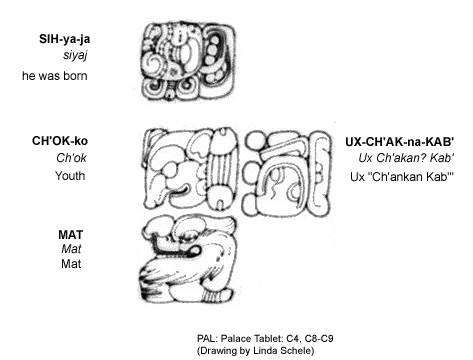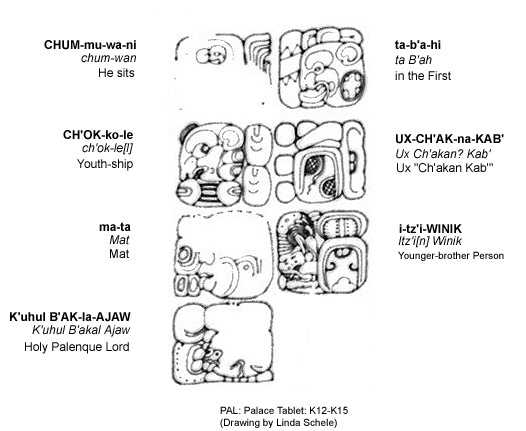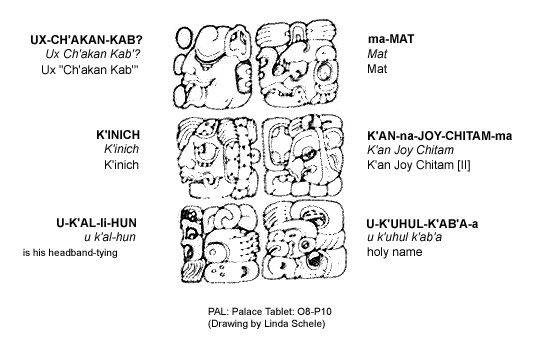
 |
WHO'S WHO IN THE CLASSIC MAYA WORLD Peter Mathews |
|
|
Classic Maya Names: Royal Names The Classic Maya individuals referred to in the inscriptions fall into two categories: rulers and others. There are indications that the names of rulers as we know them were royal names, usually adopted upon their accession. This is most clearly indicated at Palenque and Piedras Negras, where we have evidence of the child names of several rulers as well as some explicit references to royal names. For example, the inscription of the Palace Tablet at Palenque begins with the birth of the future king K'inich K'an Joy Chitam II. In the lengthy statement of his birth his royal name does not occur. Rather, he is named with glyphs that commonly occur in later references to K'inich K'an Joy Chitam II: Ch'ok "Ux Ch'akan Kab'" Mat.
'The Youth Ux "Ch'akan Kab'" Mat was born.' The first of these glyphs, ch'ok, is generally translated loosely as 'the youth', and has the implication that the person named is a junior member of his lineage. It doesn't necessarily mean simply that the individual is very young-even older individuals could be called ch'ok if they were not the leading lineage member. In addition, there is evidence of 'upward mobility': one could become the B'a Ch'ok, 'First Youth'. And in fact this happened to the future K'inich K'an Joy Chitam II upon the accession of his elder brother, K'inich Kan B'alam II, as king. On the Palace Tablet, following the statement recording the accession of K'inich Kan B'alam II, we are told that the future K'inich K'an Joy Chitam II, who was the younger brother of K'inich Kan B'alam II, became the 'First Youth', in this case the heir apparent to the throne of Palenque.
'Ux "Ch'akan Kab'" Mat, the Younger-brother Person and Holy Palenque Lord, But I digress. The issue at hand here is that of royal names for Clasic Maya kings. The Palace Tablet goes on to record the accession of K'inich K'an Joy Chitam II, which is in fact the central focus of this beautiful inscription. The accession date is (9.13.10.6.8) 5 Lamat 6 Xul (30 May 702), and towards the end of the lengthy accession phrase is the child name of the new king, Ux "Ch'akan Kab'" Mat'. The next four glyphs explicitly give his royal name:
'... 'Ux "Ch'akan Kab'" Mat. K'inich K'an Joy Chitam [II] is his holy accession name.' Earlier in the Palace Tablet, we are also explicitly given the royal name of K'inich Kan B'alam II. A panel now in Emiliano Zapata, Tabasco, records his birth date, and we are told that his name was 'Kan B'alam'. If this was indeed his birth name, it appears that his royal name changed only with the adoption of the honorific prefix K'inich, 'Sun-faced'. Another accession name is recorded at Piedras Negras. The text on the Left Side of Stela 14 begins with the accession date (A1-A11) of Yo'nal Ak III in AD 758. After the verb for accession (B11), the child name of Yo'nal Ak III is recorded (A12-A13). The next three glyphs (B13-B14) say 'Yo'nal Ak [III] is his accession name', paralleling the 'royal name' statements on Palenque's Palace Tablet. Explicit statements of Classic Maya royal names like the ones mentioned above are quite rare. In other cases, differences between the names of individuals before became king and the names they used once in power imply that the pattern was widespread. In the case of many Classic Maya kings, however, only one name has survived: generally it can be assumed that this name is their royal name. |
||
Previous Page | Introductory Page | Next Page | ||
|
Text links to all pages at this site are available at the FAMSI INDEX |
||


